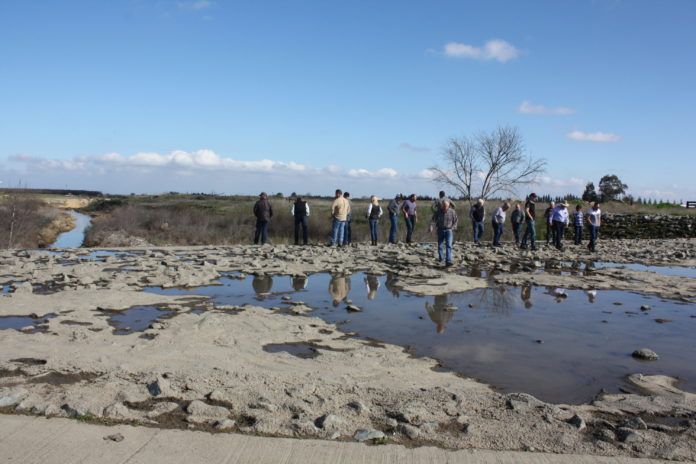 The Exchange Contractors board of directors met on Friday, October 1, 2021, at its Los Banos headquarters and on GoToMeetings. It’s October and I’m going to add already, it seemed like September was very long month. I woke up at 4:30am, very early for me and stepped outside. It was chilly, a sensation I haven’t felt for a while. You’ll hear in the report
The Exchange Contractors board of directors met on Friday, October 1, 2021, at its Los Banos headquarters and on GoToMeetings. It’s October and I’m going to add already, it seemed like September was very long month. I woke up at 4:30am, very early for me and stepped outside. It was chilly, a sensation I haven’t felt for a while. You’ll hear in the report about record setting water levels but keep in mind today’s Ex Con meeting lasted less than an hour. I have spent three hours in an Ex Con meeting in the past. I’m not complaining, it’s just a little disorienting to sail through a meeting this quickly. Good for them.
about record setting water levels but keep in mind today’s Ex Con meeting lasted less than an hour. I have spent three hours in an Ex Con meeting in the past. I’m not complaining, it’s just a little disorienting to sail through a meeting this quickly. Good for them.
The Meeting
Chairman Jim O’Banion called the meeting to order at 9:00am and we saluted the flag. The minutes were approved and there was no public comment. Joann White gave the financial reports and they were approved unanimously. Executive Director Chris White, also known as Mrs. White’s husband, gave the2022 draft budget update. He said there was some question about applying some WINN Act funds that worked out well. The consultant expense is a little higher but over all it sounded like the final expenses are expected to be lower this coming year. This was informational and White said he will come around to the home boards and make this presentation. The board agreed. Also, the financial committee minutes were approved.
Water Report
Adam Hoffman, Water Master said Ex Con is running on 1,300 cfs and about half of that is wildlife refuge deliveries. The San Joaquin River restoration flows were curtailed in June and should start up again this month. The reservoir storage across the state is low. Shasta’s at 40 percent of average for this time of year. Pine Flat is low at 59 percent but Millerton is above average, 142 percent. It sounded like the upstream power storage is starting to make its way down the hill. Inflow for Shasta is the lowest recorded in more than 100 years.
Millerton is above average, 142 percent. It sounded like the upstream power storage is starting to make its way down the hill. Inflow for Shasta is the lowest recorded in more than 100 years.
The Jones Plant went from three units to one and is back to two units. The third might go back on this month. There is 7,440 cfs inflow into the Delta and Jones is pumping 2,685 cfs. White said Shasta releases are going to be determined on how much rain hits the Sacramento Valley between now and I guess the end of the year. EX O Report
EX O Report
White reported that his report will begin with Central California Irrigation District General Manager Jarred Martin to report on SGMA. Martin said the next step is to coordinate with other neighboring subbasins to define the areas of impact, mostly western Madera County. Lower aquifer extractions are going to be the main focus. He reminded everyone DWR has until the end of the year to review the Groundwater Sustainability Plans.
other neighboring subbasins to define the areas of impact, mostly western Madera County. Lower aquifer extractions are going to be the main focus. He reminded everyone DWR has until the end of the year to review the Groundwater Sustainability Plans.
White reported the continuing resolution was passed and WINN Act and other funds are available for drought and wildfire needs. He said there has been progress on the extra water plans like Orestimba Creek.
Evidently Director of Policy Steve Chedester couldn’t attend today and his written report was given to the board. The information contained dealt with amongst other things working with the US Bureau of Reclamation on San Joaquin River restoration matters. The Bureau is about six months behind schedule for the 60 percent design mark. There isn’t any current land condemnation taking place. Attorney Andy McClure gave the board an updated version of the Brown Act requirements due to continuing Cootie control. This required the board to pass a resolution so the Ex Con board can be in compliance. We’ll see what happens in the next month or two. The board approved.
Attorney Andy McClure gave the board an updated version of the Brown Act requirements due to continuing Cootie control. This required the board to pass a resolution so the Ex Con board can be in compliance. We’ll see what happens in the next month or two. The board approved.
Water Resources
The next item was the water resources plan. White reported on Del Puerto Canyon saying an RFQ has got four responses and that will be followed up on. There’s a lot of information needed to get a good dam design and that means RFPs will be sent out soon. There should be a selection of a firm by the end of the year.
Political consultant Dominic Demaro gave a state legislative report saying a bad bill was defeated from some assemblyman from the coast, and I didn’t get the details but it sounded like a good thing. However, State Senator Melissa Hurtado’s SB 559 was pulled because the environmental community monkied with it to the point it was no longer going to be what it was meant to be, an infrastructure bill. There’s a consultant named Alf Brant who advises the Assembly speaker and evidently he’s all in on anything the enviros want. There wasn’t much water money in the budget even though revenue was much higher than expected. The one-time $70 billion was spent elsewhere like homelessness, we’ll see how that works out. The drought is raising awareness on water and the State Board’s perceived powers may include pulling curtailments on pre-1914 rights.
sounded like a good thing. However, State Senator Melissa Hurtado’s SB 559 was pulled because the environmental community monkied with it to the point it was no longer going to be what it was meant to be, an infrastructure bill. There’s a consultant named Alf Brant who advises the Assembly speaker and evidently he’s all in on anything the enviros want. There wasn’t much water money in the budget even though revenue was much higher than expected. The one-time $70 billion was spent elsewhere like homelessness, we’ll see how that works out. The drought is raising awareness on water and the State Board’s perceived powers may include pulling curtailments on pre-1914 rights.
Attorney’s Report
McClure said the enviros are trying to bundle all the potential lawsuits on SGMA into one case and that’s a foolish move but they might pull it off. There were many other items of potential and ongoing litigation but much of it will be in closed session.
Four Managers’ Report
Martin reported the deliveries are slowing down and his district is testing some lower velocity management technics and they will dewater for maintenance and repairs.
Randy Houk, GM Columbia Canal Company reported they are preparing for winter maintenance.
John Wiersma, GM San Luis Canal Company said there are three bid packages for outside contractors to start some winter maintenance projects by December. They are preparing for a potentially dry year.
Jeff Bryant, GM Firebaugh Canal Water District said he’s spending a lot of time working on wells and the new office. He’s working on winter maintenance as well.
There was no informational items today and the meeting went into closed session at 9:52am. That was that, go be good to yourselves and each other.
DISCLAIMER OF RESPONSIBILITY; Waterwrights.net strives to provide its clients with the most complete, up-to-date, and accurate information available. Nevertheless, Waterwrights.net does not serve as a guarantor of the accuracy or completeness of the information provided, and specifically disclaims any and all responsibility for information that is not accurate, up-to-date, or complete. Waterwrights.net’s clients therefore rely on the accuracy, completeness and timeliness of information from DAW entirely at their own risk. The opinions expressed in this report are those of the author and do not represent any advertisers or third parties.
that is not accurate, up-to-date, or complete. Waterwrights.net’s clients therefore rely on the accuracy, completeness and timeliness of information from DAW entirely at their own risk. The opinions expressed in this report are those of the author and do not represent any advertisers or third parties.
ALL RIGHTS RESERVED. Copyright 2021 by WaterWrights.net/DAW
SAN JOAQUIN RIVER EXCHANGE CONTRACTORS WATER AUTHORITY
Main Office: 541 H Street, P.O. Box 2115 Los Banos, CA 93653 Office 209/827-8616 www.sjrecwa.net Email: contactus@sjrecwa.net
DWR SGMA Identifier #5-022.07
The Exchange Contractors cover almost a quarter of a million acres in Fresno, Madera, Merced and Stanislaus Counties.
Mission Statement
The Exchange Contractors Water Authority mission is to effectively protect the Exchange Contract and maximize local water supply, flexibility and redundancy in order to maintain local control over the members’ water supply.
Board
James O’Banion-Chair Central California Irrigation District, Chris Cardella-Vice Chair Columbia Canal Company, James L. Nickel-Treasurer San Luis Canal Company, Mike Stearns-Director Firebaugh Canal Water District
Staff
Chris White-Executive Director, Steve Chedester- Director Policies & Programs, Adam Hoffman-Water Resources Specialist, Joann White-Director Finance and Human Resources, Darlene O’Brien- Administrative Assistant, Paul Minasian-Attorney
History
From the Exchange Contractors’ website: www.sjrecwa.net The San Joaquin River Exchange Contractors hold some of the oldest water rights in the state, dating back to the late 1800s. The rights were established by Henry Miller of the legendary Miller and Lux cattle empire. In 1871, Henry Miller constructed canals to divert water from the San Joaquin and North Fork of the Kings Rivers for irrigation of his vast acreage. Today, several of the original Miller and Lux canals are operated by the Exchange Contractors.
Although Henry Miller’s canals served the irrigation needs of his estate in the western portion of Fresno, Madera, Merced, and Stanislaus counties, in order for more growth on the east side of the San Joaquin Valley to occur, more water was needed. In 1933, the United States Department of Interior undertook the Central Valley Project, a vast undertaking to build dams throughout the great Central Valley including the Sacramento, American and San Joaquin Rivers. When construction of the Friant Dam (north of Fresno) was under consideration, feasibility studies showed that irrigation development of the Friant Project between Chowchilla and Bakersfield depended upon water being diverted from the San Joaquin River at Friant Dam and brought to the east side of the valley, via the Friant-Kern Canal.
To accomplish this, the government asked the heirs of Miller and Lux to agree to “exchange” where they receive their pre-1914 appropriative and riparian water from the San Joaquin and Kings Rivers for guaranteed deliveries of “substitute” water from the Sacramento River by means of the Delta-Mendota Canal and other facilities of the United States. This agreement, known as the “Exchange Contract,” along with the accompanying “Purchase Contract,” were reached in 1939 and that led to the name “San Joaquin River Exchange Contractors.” In normal years, the Exchange Contractors are guaranteed 100% of their contractual water allotment (840,000 acre feet) and in critical years the amount is 75% (650,000 a/f).
The Exchange Contractors, however, did not abandon their San Joaquin River water rights. Instead, they agreed not to exercise those San Joaquin and Kings Rivers’ water rights if guaranteed water deliveries continued through the Delta-Mendota Canal or other facilities of the United States.
































